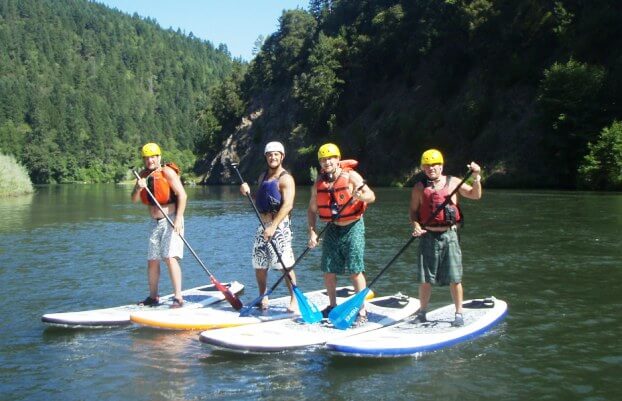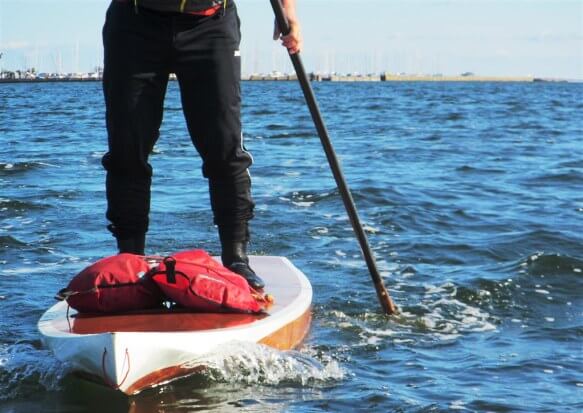How Do You Stay Safe while Paddle Boarding? Follow These 13 Rules
What are the most helpful safety rules for stand up paddle boarding?
If you are in a hurry, these SUP safety rules are as follows:
- Ensure your iSUP or solid board is in great shape
- SUP board is a vessel, so you need a PFD
- Know how to swim for your paddleboarding safety
- Keep your SUP leash attached
- Wear a helmet when paddleboarding in wild waters
- Wait for best weather for stand up paddleboarding or wear a wetsuit
- Carry your whistle and mobile phone
- Cover any open wounds
- Choose the best time to paddle board in ocean
- Do not paddle board too far from other people
- Know your skill or experience level
The safety rules for paddleboarding apply to everyone, whether you are an advanced SUP enthusiast or just a beginner.
For example, you need to know some things such as: What is the best time to paddle board in ocean? This is when the water is calm.
That way, you will not do it at high tide with the wind behind you. The paddle board can slice through the waves like a hot knife slices through butter.
Must-Know Safety Rules for Stand Up Paddle Boarding

If you are a paddling beginner, do not get into the water with your inflatable or solid SUP board without knowing a few important rules for your safety.
Keep reading to see our recommendations for paddleboarding safety for beginners and experts.
1. Choose the right SUP board
Choosing the best SUP board is very important. First, you can make it a solid or inflatable paddle board.
Inflatable boards are also more affordable, and more readily available. The solid boards, such as the Easy Eddy 3-piece paddle board, are costlier.
Secondly, the profile of the board is very important. Thicker boards are more stable than thin ones. Between a 4 inch or 6 inch paddle board, go for the thicker one.
2. Ensure your iSUP or solid board is in great shape
In the water, any person is as good as their gear. Therefore, for your SUP safety, make sure that your gear is in great shape.
For example, check the stand up paddle board for dents or tears, especially if you are using an inflatable board.
In addition, as a beginner, you should carry as much gear as you can. Therefore, even if you feel that you want to wear a t-shirt, a pair of snorkel shoes and even a helmet, go ahead. It is better to err on the side of caution.
An inflatable SUP board requires to be inflated to the right PSI. Therefore, you need to check that it has enough inflation.
Check to ensure that your paddle is in great shape, too. Also, make sure the leash works correctly, since it keeps you attached to the board by your leg.
3. SUP board is a vessel, so you need a PFD
The US Coast Guard classifies a stand up paddle board as a vessel. In addition, you are required to have a PFD – personal flotation device on board if you are older than 13 years.
If you are younger than that, you need to wear the personal flotation device on your person all the time that you will be using your board.
Personal flotation devices that you can use on your board are type 3 life jackets, type 2 life jackets and so on.
4. Know how to swim for your paddleboarding safety
Perhaps you will not find this requirement in any rule book, but that does not mean that it is not important for your paddleboarding safety.
When you are beginning out, you are surely going to fall off the paddle board a couple of times. Therefore, you need to know how to swim.
We recommend that you should try to fall as far away from your board as possible. That way, you will not hit your head or shoulder on the board, which could cause excruciating pain.
Therefore, you will definitely need to swim to get to your board. When using an inflatable SUP board, it could get pierced by something in the water and deflate. In that case, you would have to swim back to the shore.
5. Always wear a leash
A leash is the only attachment you have to the SUP board. Thankfully, it comes with the package that you order on Amazon.com, and if not, you can order it separately. You can also get the ankle or calf SUP leash.
If you fall into the water, the board will not float away with the current, because it is attached to the leash. Also, make sure the SUP paddle can float so that it does not sink if it slips and falls into the water.
6. Wear a helmet when paddling in wild waters
This is very important when you are paddleboarding in a rock, trees and debris studded river. Remember, even when wild water kayakers go for white water kayaking, they wear their helmets.
It is also vital that you do so since your fall can be detrimental considering that you will be falling from a height. Even if there are no visible rocks in the river, lake or ocean, it is better to wear a helmet because it can protect your head if you hit it against the board when falling.
7. Wait for best weather for paddle boarding or wear a wetsuit
What is the best weather for stand up paddle board? Well, of course, sunny summer or spring is always best.
However, nothing should stop you as long as there are no weather warnings in your stand up paddleboarding destination in winter and fall.
If the weather is cold, you should wear a wetsuit so that you can trap your body warmth against the skin. A wetsuit keeps the cold out and the warmth in.
If you paddle board in cold weather without the proper protection, you will suffer from hypothermia.
8. Do not paddle board too far from other people
This is one of the most important safety rules for paddleboarding. Always stay close to other ocean users.
If you can bring a friend along to paddle board with you, do it. You will feel more confident since your paddleboarding safety is assured. In addition, rescue comes faster than when you are paddling in isolation.

9. Carry your whistle and mobile phone
A whistle is one of the must-have items for your paddleboarding safety. Therefore, always have one on your person. That way, when you need rescue, you can blow your whistle to attract attention.
However, sometimes, the whistle might not be enough. Therefore, bring a cellphone. You can keep these things in a dry pouch attached to your person.
10. Don’t paddle board when the wind is behind your back
Wind is a serious threat for both beginners and advanced paddleboarders. Therefore, if the wind is blowing from the shore towards the sea, it is better to postpone your SUP adventure.
Your body will act as the sail and with the wind behind you, you might sail away into the open sea.
11. Cover any open wounds
The ocean and indeed rivers and lakes carry a lot of germs. Therefore, if you have any open wounds, please cover them properly. Besides, you do not want the salty ocean water getting into your wound since it can cause pain.
Just to mention it, you should never drink the same water that you are paddling on. Therefore, carry your drinking water because stand up paddling can be thirsty work.
12. Choose the best time to paddle board in ocean
The ocean is easily the biggest tomb in the world. Many sailors, swimmers and travelers have been swallowed into the bowels of the sea, never to return.
As one of your paddleboarding safety tips, know the best time to paddle board in the ocean.
Choose evening for stand up paddleboarding. By evening, winds tend to have reduced their speed. In addition, the water is usually more calm.
If you are a beginner, the best time to paddle board in ocean waters is when there are no waves. If you are an expert, you will love to have some wind behind your back to enjoy speed.
High tide or low tide for SUP safety? Well, this depends. For example, low tide can push some nasty waves to the shore. The water might be too far, thereby forcing you to carry your board to a distance.
High tide is best for paddle board safety, but do it when the waters are still.
13. Know your skill level
Do not overrate yourself, especially when paddleboarding in the ocean. It can be one unforgiving surge of power.
If you are a beginner, you need to start with smaller depths. For instance, knee-deep water (20 to 30 inches) is recommended.
At that depth, you will be safe, but be keen not to fall off the board as that could expose you to the risk of breaking your ankle.
Waist-deep, neck-deep and deeper waters are best left to people who have some skill and experience. You can read more about this in my post on whether you can paddle board if you can’t swim.
Also check my other posts on:
Is it safe to paddleboard in winter?
Best lakes for paddle boarding near me in the US
Conclusion
These are the basic safety rules for stand up paddle boarding. Is there anything else, you know, apart from wearing sunscreen to protect your skin that you can think of?
You can let me know in the comments. The most important thing is to adhere by these rules so that you can have crazy fun in the water.
Stand up paddling is a lot of fun, and it can also make you fit as a fiddle.

